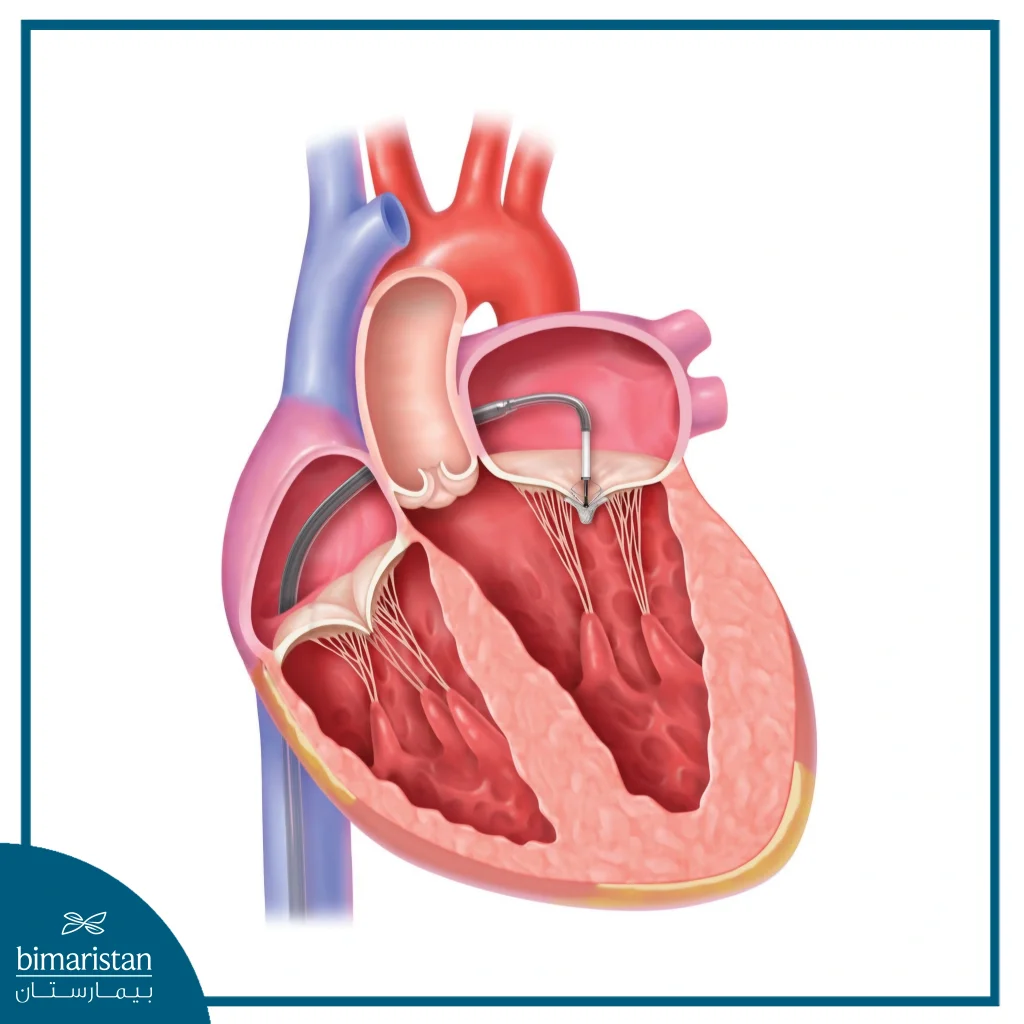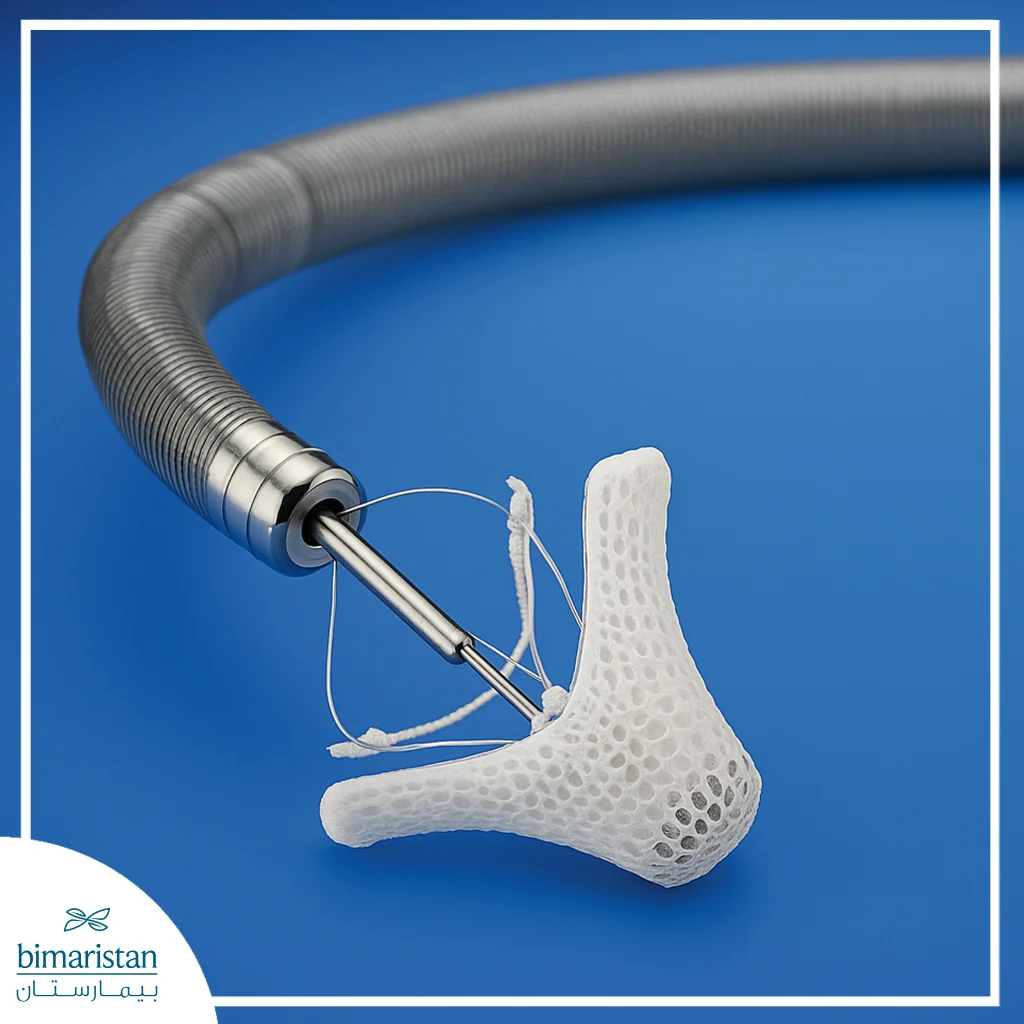The mitral valve is one of the most important heart valves, and any malfunction in its function can lead to serious health issues that affect the patient’s daily life. With the advancement of medicine, new techniques have emerged to treat mitral valve regurgitation in ways that are less risky than traditional surgery, most notably the MitraClip procedure, which has become an advanced option for patients who are not suitable for open surgery.
This procedure has revolutionized the field of valve repair, providing patients with a faster recovery, improved symptoms, and a better quality of life, while reducing the need for lengthy hospital stays through its minimally invasive, catheter-based approach that avoids the need for chest opening.
What is a mitral valve, and what does it do?
Located between the left atrium and left ventricle of the heart, the mitral valve acts as a one-way valve that allows blood to pass from the atrium to the ventricle when the heart is full, and then closes when the ventricle contracts to prevent blood from flowing backwards. By this mechanism, the valve ensures efficient blood flow throughout the body.
In some cases, the valve may not close completely, causing blood to leak back into the left atrium, a condition known as mitral valve regurgitation. This disorder is the main reason why the patient needs medical intervention, because over time it puts an extra burden on the heart and causes unpleasant symptoms such as shortness of breath, fatigue, and fluid buildup in the lungs.
What is the MitraClip procedure?
The MitraClip procedure, also known as a mitral valve clip, is a minimally invasive procedure used to repair mitral valve regurgitation without the need for open-heart surgery. The procedure is performed through a flexible catheter, usually inserted through a groin vein, and precisely guided to the heart, where the doctor attaches a small device called a MitraClip to the two mitral valve leaflets. This clip brings the two leaflets closer together to minimize blood reflux, while maintaining an open pathway that allows blood to flow normally.
MitraClip procedure is a breakthrough in the treatment of mitral valve regurgitation, where open surgery was previously the only option. Today, MitraClip provides a safe and effective option for patients who cannot tolerate traditional surgery due to age or chronic disease, and studies have proven that it relieves symptoms, slows disease progression, and significantly improves quality of life.
Who are the candidates for MitraClip?
MitraClip is performed for patients who have severe mitral valve regurgitation but whose health condition does not allow for open-heart surgery, such as the elderly or those with chronic diseases that increase the risk of surgery. In these cases, the MitraClip procedure is a less invasive option that helps reduce symptoms and improve quality of life.
However, this technique is not suitable for all patients, and the decision is based on a comprehensive evaluation by a specialized team that includes cardiologists, cardiac surgeons, and imaging specialists. The evaluation includes accurate tests such as transesophageal echocardiography (TEE) to determine the shape of the valve and the degree of regurgitation, after which the most appropriate treatment plan is discussed, whether MitraClip, traditional surgery, or continued drug therapy.
Preparation before MitraClip
Prior to the MitraClip procedure, the patient undergoes careful preparation aimed at ensuring the safety of the procedure and achieving the best results. The preparation usually includes a combination of tests, medical instructions, and administrative procedures.
Medical tests before MitraClip surgery
A range of tests is performed to evaluate the heart and ensure patient suitability, such as:
- Blood test
- Echocardiography to assess valves and blood flow
- Transesophageal echo for better visualization of the mitral valve
- An electrocardiogram (ECG) is used to monitor heart rate and rhythm
- Coronary angiogram or CT scan to examine the heart’s arteries and blood vessels
- Staphylococcus aureus screening to detect and treat certain infections before the procedure, if necessary
MitraClip medical instructions
After completing the medical examinations and making sure the patient is ready for the procedure, the medical team provides a set of important instructions that must be followed before the operation to ensure its success and the safety of the patient. The most important of these instructions include:
- Ask the patient to stop certain medications (especially blood thinners) several days before the procedure
- Inform the medical team of all current medications and any drug sensitivities
- Adhere to fasting or other instructions as recommended by your doctor
Administrative preparation
One to two weeks before the operation, the patient is contacted through a call or an introductory appointment to review their medical history and medications, answer their questions, and set the date of admission to the hospital, usually the patient is asked to come either on the same day of the operation or the day before, depending on their condition, making sure in advance that a bed is available in the specialized department. During this stage, the patient receives all final instructions related to preparation and admission.
How the MitraClip procedure works
The MitraClip procedure is performed in a cardiac catheterization lab or hybrid operating room, an environment that combines traditional surgical equipment with advanced imaging techniques, increasing the accuracy and safety of the procedure. The procedure typically takes two to three hours under general anesthesia and is performed by a multidisciplinary team that includes an interventional cardiologist, an anesthesiologist, and a cardiac imaging expert.
The procedure begins by making a small incision in the groin area to access the femoral vein, through which a flexible catheter is inserted and guided using X-ray and Echo until it reaches the right atrium. After that, a precise hole is made in the atrial septum to reach the left atrium, a critical step because the success of the operation depends on the accuracy of this passage, then Mitral valve clip device is inserted through the catheter and precisely guided towards the mitral valve with the help of real-time imaging, and when the team is sure of the proper location, the device is fixed in place. The catheter is withdrawn, and the small incision in the groin is closed.
Studies indicate that the technique is safe in most cases, and data from specialized centers have shown success rates exceeding 95% with significant improvement in symptoms and quality of life.

How MitraClip works
The Mitral valve clip is a small metal clip that attaches directly to the two leaflets of the mitral valve. This clip brings the two leaflets together at a central point, reducing reverse blood flow (regurgitation) while maintaining normal bypass grafts that allow blood to pass properly. MitraClip is a practical and safe solution for many patients. This simple and effective mechanism makes it possible to improve valve efficiency without having to open the chest or replace the entire valve, making MitraClip a practical and safe solution for many patients.

The difference between MitraClip and traditional mitral valve repair surgery
MitraClip differs from traditional surgery in terms of the nature of the intervention and the end goal. Open surgery aims to repair or completely replace the valve and is considered the most permanent option for patients who are able to tolerate it. In contrast, MitraClip focuses on minimizing reflux and improving symptoms with minimal intervention, making it suitable for patients for whom surgery is too risky.
Surgery is the long-term, radical solution, while MitraClip offers a practical and effective solution for high-risk patients, providing a rapid improvement in quality of life with a high level of safety, which is why MitraClip is not seen as a complete replacement for surgery, but as a complementary option for a specific category of patients.
Features of MitraClip
MitraClip is one of the most significant innovations in the treatment of mitral valve regurgitation (MVR). Studies have shown that it offers patients significant benefits over open surgery, due to its minimally invasive nature that does not require opening the chest or stopping the heart. Key features:
- Significant improvement in quality of life
- Short hospital stay (1-3 days)
- Reduce the risk of death by approximately 28%
- Less pain and fewer complications than traditional surgery
- Safe catheter-based procedure without the need to open the chest
- Faster recovery time and a quicker return to daily activities
- Immediate improvement in symptoms such as shortness of breath, palpitations, and fatigue
- Long-term safety with more than 99% of patients without device-related complications after five years
These advantages make the MitraClip a practical and effective option, especially for patients who are unable to tolerate open surgery, with excellent results in improving cardiac function and quality of life.
Potential risks and complications
Although the MitraClip procedure is considered a safe and minimally invasive procedure compared to open surgery, like any medical intervention, it may carry some risks. Most studies have confirmed that complication rates are low, but the patient should be aware of them before making the decision, and the most notable potential risks include:
- Vascular issues: Bleeding or bruising at the catheter insertion site.
- The clip separates from one of the valve leaflets: This is rare, but it can lead to poor device function.
- Injury or rupture of the valve leaflets: Especially in cases where the valve is severely damaged.
- Residual valvular regurgitation: This is the most common complication and may require reintervention.
- Rare complications: Stroke or the need for conversion to open-heart surgery, but the incidence is very low (less than 1-2%).
Follow-up results indicate that most patients are discharged from the hospital without serious complications, with a high long-term safety profile.
Recovery after MitraClip surgery
Recovery after MitraClip is quicker and easier compared to open surgery, and patients often notice an improvement in symptoms immediately after the procedure. Recovery has two main phases: The first is during hospitalization, and the second is after returning home.
In the hospital
After the procedure is completed, the patient is transferred to the care unit where they are closely monitored during the first few hours. The patient usually stays one to three days in the hospital and sometimes up to five days, depending on the overall condition. During this time, heart rate, blood pressure, and breathing are continuously monitored, and fluids or medications to support the heart are given as needed.
The medical team monitors the wound in the groin area to ensure healing and prevent bleeding. Simple stitches are usually removed the next day, and an echo scan is performed before discharge to make sure the clip is working efficiently and minimizing reflux. Most patients experience a noticeable improvement in shortness of breath and fatigue immediately after the procedure.
At home
Once home, the patient receives clear instructions, including continuing to take certain medications such as blood thinners or aspirin to prevent clots, and is advised to rest and avoid heavy physical exertion or lifting heavy weights during the first few weeks, while light activities such as gradual walking can be practiced daily.
A follow-up appointment is scheduled about a month later, usually involving a new echo scan to confirm the valve’s efficiency, with a recommendation to see the doctor periodically at least once a year. In some cases, a cardiac rehabilitation program including light exercise and nutritional counseling may be suggested to promote recovery and improve heart strength. During the recovery period, pay attention to any abnormal symptoms such as severe shortness of breath, fever, or chest pain, and contact your doctor immediately if they occur.
MitraClip cost in Turkey
The MitraClip procedure is an advanced procedure that requires high expertise and specialized equipment, so its cost in Turkey usually ranges between 25,000 and 41,000 USD. The price varies depending on several factors, such as the patient’s condition, the number of clips he may need, as well as the accompanying services provided by the hospital, such as accommodation and post-operative care. Although the figures are approximate, Turkey remains a cost-competitive destination compared to European and American countries.
In conclusion, the MitraClip procedure represents a major breakthrough in the treatment of mitral valve regurgitation, offering exceptional therapeutic effectiveness and safety without the need for open-heart surgery. With this advanced technology now available in leading medical centers in Turkey, patients can access modern, reliable treatment that meets international standards and helps them recover and return to normal life with improved heart function.
Sources:
- Sherif, M. A., Paranskaya, L., Yuecel, S., Kische, S., Thiele, O., D’Ancona, G., Neuhausen-Abramkina, A., Ortak, J., Ince, H., & Öner, A. (2017). MitraClip step by step; how to simplify the procedure. Netherlands heart journal: Monthly journal of the Netherlands Society of Cardiology and the Netherlands Heart Foundation, 25(2), 125-130. https://doi.org/10.1007/s12471-016-0930-7
- Chakravarty, T., Makar, M., Patel, D., Oakley, L., Yoon, S. H., Stegic, J., Singh, S., Skaf, S., Nakamura, M., & Makkar, R. R. (2020). Transcatheter edge-to-edge mitral valve repair with the MitraClip G4 system. JACC: Cardiovascular Interventions, 13(20), 2402-2414. https://doi.org/10.1016/j.jcin.2020.06.053
- Rodriguez, E., Raissi, R., Bott, M., & Morse, M. A. (2021). MitraClip™: a step by step guide for surgeons. Annals of Cardiothoracic Surgery, 10(1), 180-182. https://doi.org/10.21037/acs-2020-mv-19

